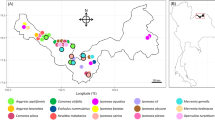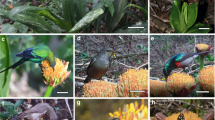Abstract
We report a new obligate pollination mutualism involving the senita cactus, Lophocereus schottii (Cactaceae, Pachyceereae), and the senita moth, Upiga virescens (Pyralidae, Glaphyriinae) in the Sonoran Desert and discuss the evolution of specialized pollination mutualisms. L. schottii is a night-blooming, self-incompatible columnar cactus. Beginning at sunset, its flowers are visited by U. virescens females, which collect pollen on specialized abdominal scales, actively deposit pollen on flower stigmas, and oviposit a single egg on a flower petal. Larvae spend 6 days eating ovules before exiting the fruit and pupating in a cactus branch. Hand-pollination and pollinator exclusion experiments at our study site near Bahia Kino, Sonora, Mexico, revealed that fruit set in L. schottii is likely to be resource limited. About 50% of hand-outcrossed and open-pollinated senita flowers abort by day 6 after flower opening. Results of exclusion experiments indicated that senita moths accounted for 75% of open-pollinated fruit set in 1995 with two species of halictid bees accounting for the remaining fruit set. In 1996, flowers usually closed before sunrise, and senita moths accounted for at least 90% of open-pollinated fruit set. The net outcome of the senita/senita moth interaction is mutualistic, with senita larvae destroying about 30% of the seeds resulting from pollination by senita moths. Comparison of the senita system with the yucca/yucca moth mutualism reveals many similarities, including reduced nectar production, active pollination, and limited seed destruction. The independent evolution of many of the same features in the two systems suggests that a common pathway exists for the evolution of these highly specialized pollination mutualisms. Nocturnal flower opening, self-incompatible breeding systems, and resource-limited fruit production appear to be important during this evolution.
Similar content being viewed by others
Author information
Authors and Affiliations
Additional information
Received: 19 August 1997 / Accepted: 24 November 1997
Rights and permissions
About this article
Cite this article
Fleming, T., Holland, J. The evolution of obligate pollination mutualisms: senita cactus and senita moth. Oecologia 114, 368–375 (1998). https://doi.org/10.1007/s004420050459
Issue Date:
DOI: https://doi.org/10.1007/s004420050459




